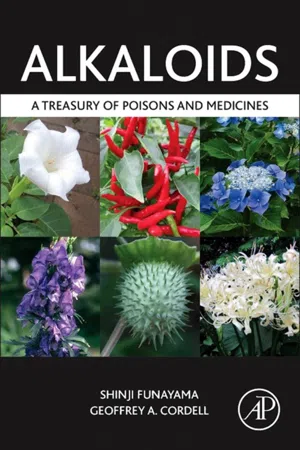
eBook - ePub
Alkaloids
A Treasury of Poisons and Medicines
Shinji Funayama,Geoffrey A. Cordell
This is a test
Partager le livre
- 294 pages
- English
- ePUB (adapté aux mobiles)
- Disponible sur iOS et Android
eBook - ePub
Alkaloids
A Treasury of Poisons and Medicines
Shinji Funayama,Geoffrey A. Cordell
Détails du livre
Aperçu du livre
Table des matières
Citations
À propos de ce livre
Alkaloids are a large group of structurally complex natural products displaying a wide range of biological activities. The purpose of Alkaloids: A Treasury of Poisons and Medicines is to classify, for the first time, the alkaloids isolated from the natural sources until now. The book classifies all of the alkaloids by their biosynthetic origins. Of interest to the organic chemistry and medicinal chemistry communities involved in drug discovery and development, this book describes many alkaloids isolated from the medicinal plants, including those used in Japanese Kampo medicine.
- Classifies and lists alkaloids from natural sources
- Occurrence and biosynthetic pathways of alkaloids
- Indicates key uses and bioactivity of alkaloids
Foire aux questions
Comment puis-je résilier mon abonnement ?
Il vous suffit de vous rendre dans la section compte dans paramètres et de cliquer sur « Résilier l’abonnement ». C’est aussi simple que cela ! Une fois que vous aurez résilié votre abonnement, il restera actif pour le reste de la période pour laquelle vous avez payé. Découvrez-en plus ici.
Puis-je / comment puis-je télécharger des livres ?
Pour le moment, tous nos livres en format ePub adaptés aux mobiles peuvent être téléchargés via l’application. La plupart de nos PDF sont également disponibles en téléchargement et les autres seront téléchargeables très prochainement. Découvrez-en plus ici.
Quelle est la différence entre les formules tarifaires ?
Les deux abonnements vous donnent un accès complet à la bibliothèque et à toutes les fonctionnalités de Perlego. Les seules différences sont les tarifs ainsi que la période d’abonnement : avec l’abonnement annuel, vous économiserez environ 30 % par rapport à 12 mois d’abonnement mensuel.
Qu’est-ce que Perlego ?
Nous sommes un service d’abonnement à des ouvrages universitaires en ligne, où vous pouvez accéder à toute une bibliothèque pour un prix inférieur à celui d’un seul livre par mois. Avec plus d’un million de livres sur plus de 1 000 sujets, nous avons ce qu’il vous faut ! Découvrez-en plus ici.
Prenez-vous en charge la synthèse vocale ?
Recherchez le symbole Écouter sur votre prochain livre pour voir si vous pouvez l’écouter. L’outil Écouter lit le texte à haute voix pour vous, en surlignant le passage qui est en cours de lecture. Vous pouvez le mettre sur pause, l’accélérer ou le ralentir. Découvrez-en plus ici.
Est-ce que Alkaloids est un PDF/ePUB en ligne ?
Oui, vous pouvez accéder à Alkaloids par Shinji Funayama,Geoffrey A. Cordell en format PDF et/ou ePUB ainsi qu’à d’autres livres populaires dans Naturwissenschaften et Organische Chemie. Nous disposons de plus d’un million d’ouvrages à découvrir dans notre catalogue.
Informations
Sujet
NaturwissenschaftenSous-sujet
Organische ChemieChapter 1
Alkaloids Derived from Phenylalanine and Tyrosine
Abstract
This chapter introduces those alkaloids derived from phenylalanine and tyrosine.
Keywords
Aristolochic acid; Berberine; Chelidonine; Coclaurine; Colchicine; d-tubocurarine; Dopamine; Emetine; Galanthamine; L-DOPA; Lycorine; Morphine; Phenylethylamine; Thyroxine
The thousands of alkaloids derived from phenylalanine and tyrosine possess a wide range of important biological activities, and several of them are pharmaceutical agents, present in various traditional medicines in various systems, or serve as biological tools. In this chapter, those alkaloids are discussed, from the simplest alkaloids to those that represent more complex chemical structures. The coclaurine-type alkaloids are one of the simplest of these alkaloids, and are described in Section 1.4. Among them, reticuline, in its antipodal forms, is an important biosynthetic precursor of various alkaloids, including such alkaloids as berberine and morphine. Some of the alkaloids of this type are derived through highly complicated, and incompletely understood, biosynthetic pathways. For example, it is very difficult to elucidate the original amino acid derivations of colchicine (Section 1.11) and lycorine (Section 1.13) from a superficial examination of their chemical structures.
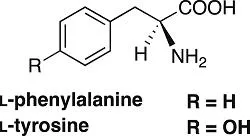
Both phenylalanine and tyrosine are derived from chorismic acid, which is itself derived from shikimic acid-3-phosphate through the shikimic acid pathway. In this sequence, chorismic acid is first transformed into prephenic acid by chorismate mutase. If prephenic acid is converted into phenylpyruvic acid by the action of prephenate dehydratase and a transaminase, phenylalanine is formed. On the other hand, if it is transformed into 4-hydroxyphenylpyruvic acid by the action of prephenate dehydrogenase, followed by a transaminase reaction, then tyrosine is formed.
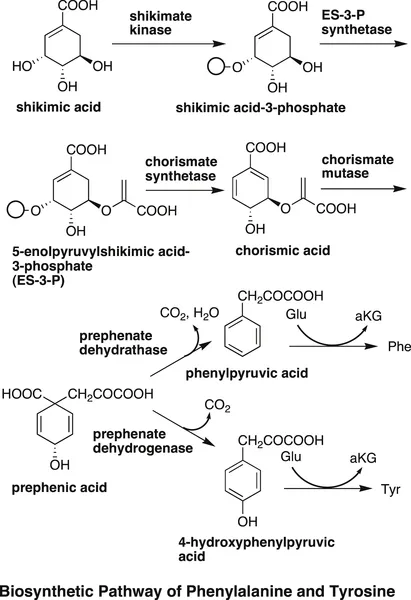
1.1
Phenylethylamines (Phenethylamines)
Peyote (Lophophora williamsii, syn. Anhalonium williamisii) is a cactus and member of the family Cactaceae, and grows wild in the deserts of Mexico and the southern United States [1]. The cactus is also cultivated in Japan as a decorative plant and known as “Ubatama.”
This cactus is an important source of the so-called phenylethylamine (phenethylamine) alkaloids with a C6C2N skeleton. The main component of the alkaloid mixture is mescaline. The name mescaline is derived from the name of the cactus, which is also known as “mescal buttons.” Mescaline is known to possess hallucinatory effects and a number of undesirable side effects. With respect to the biosynthesis of mescaline, it was shown that L-tyrosine is oxidized to give L-DOPA (L-3,4-dihydroxyphenylalanine), which is transformed to the biosynthetic precursor dopamine (3,4-dihydroxyphenethylamine) [2], which is selectively O-methylated to afford 3-O-methyldopamine, a key biosynthetic precursor of the alkaloid. The direct biosynthetic precursor of mescaline was determined to be 3,5-dimethoxy-4-hydroxyphenethylamine, because 3,4,5-trihydroxy phenethylamine and 3,4-dimethoxy-5-hydroxyphenethylamine were not incorporated into the biosynthetic pathway to mescaline [2].
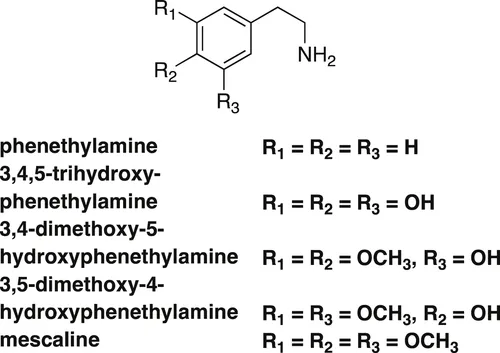
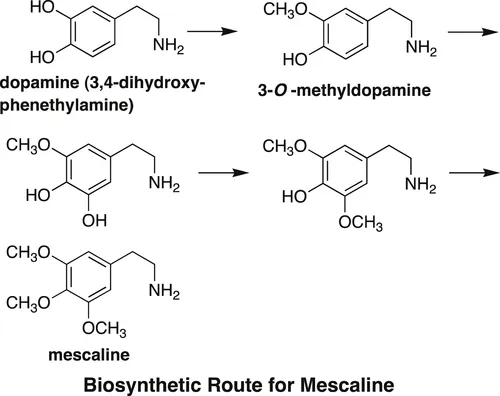
Hordenine and N-methyltyramine are isolates from the young roots of Hordeum vulgare var. hexastichon (Poaceae), and are simple phenylethylamine-type alkaloids. The biosynthetic precursor of these alkaloids is considered to be tyramine, derived from tyrosine. dl-[2-14C]-Tyrosine was fed to H. vulgare var. hexastichon 4 days after germination, and hordenine and N-methyltyramine were isolated after 11 days from the roots. Both alkaloids possessed 14C label at the α-carbon. It was also found that dl-[2-14C]-tyrosine was more effectively incorporated into N-methyltyramine than into hordenine, and no tyramine was detected in the extract. So, the incorporated tyrosine was converted into tyramine and methylated immediately to give N-methyltyramine. Subsequent steps form hordenine by the methylation of N-methyltyramine [3].
On the other hand, it was clarified by the incorporation of labeled methionine that the methyl groups incorporated during the biosynthesis of N-methyltyramine and hordenine were derived from methionine. The yield of N-methyltyramine in these experiments is less than half that of hordenine; however, the incorporation of 14C into N-methyltyramine is 1.5 times that of hordenine. This indicates that N-methyltyramine is not formed by the demethylation of hordenine, but th...